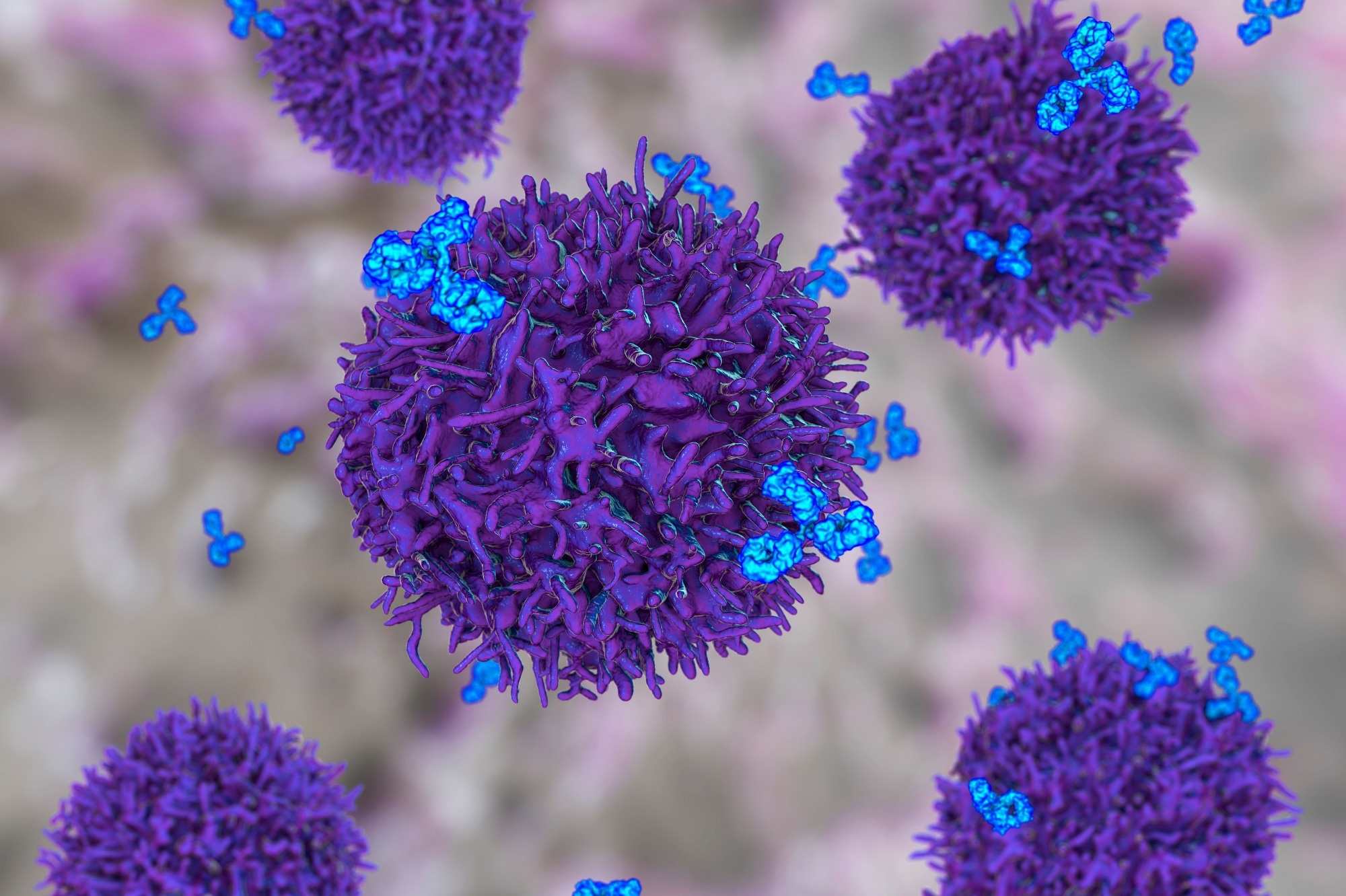In a recent study published in Cancers, researchers comprehensively summarized all available information about B cells in the context of breast cancer. In addition, they explored their clinical relevance as biomarkers in next-generation therapeutic interventions for breast cancer.

They also developed a novel platform to investigate single-cell ribonucleic acid sequencing (scRNA-seq) data focused on B cells gathered from multiple breast cancer studies that are now available publically. They named this user-friendly platform – the “B singLe cEll RNA-Seq browSer” (BLESS) platform.
BLESS facilitates investigating and visualizing human datasets comprised of B cells from a suite of breast tumors, including primary tumors, peripheral blood mononuclear cells (PBMCs), lymph nodes (LNs), and even normal breast tissue. This comprehensive database shows all B cell types in different immunological sites of breast cancer patients facilitating cancer-related investigations before, during, or after treatment.
In addition, BLESS delineated all B cell phenotypes and their communication networks with nearby cells in TME, such as fibroblasts, macrophages, endothelial cells (ECs), and other tumor-infiltrating lymphocytes (TILs). Most importantly, the source code of BLESS is apt for sharing. Its expandable functionalities present the opportunity to inspect and compare tumor-infiltrating B cells (TIL-B) in different clinical settings.
Overall, BLESS platform could help elucidate the multi-functional roles of B cells in breast cancer pathology.
Background
The majority of breast cancer cases are intrinsically heterogeneous, with 65% classified as estrogen receptor (ER)-positive, and the remaining 20% and 15% as human epidermal growth factor receptor 2 (HER2)-positive and triple-negative breast cancers (TNBC)-positive, respectively.
These breast cancer subtypes express differential quantities and assortments of tumor-associated antigens (TAA) and tumor-specific antigens (TSA), which, in turn, affect the recruitment and expansion of TILs that impact tumor progression. Thus, studies have aimed to dissect the diverse TILs subsets and their diverse functions to uncover additional targetable biomarkers for all breast cancer types.
Pathological TILs assessment could capture little variations in the immune cell populations present, including tumor-infiltrating T cells (TIL-T) and TIL-B. The level of these immune cells demonstrates prognostic value for overall survival in HER2- and TNBC-positive patients with breast cancer.
Within the tumor microenvironment (TME), B and T cells present antigens and synthesize antibodies that confer independent anti-tumor cytotoxicity. Given their crucial role in adaptive immune responses, B cells likely play a crucial role in anti-tumor immunity. As their interference might have a substantial impact on immunotherapeutic approaches, B cells must not be disregarded when assessing TILs in breast cancer patients.
B cells and their role in breast cancer pathology
B cells primarily originate from hematopoietic stem cells in the bone marrow. Mature B cells migrate through the bloodstream or lymphatic system to secondary lymphoid organs. Following antigen exposure, these cells undergo differentiation to establish a germinal center (GC) or generate short-lived plasma cells.
Within the GC, following rounds of somatic hypermutation, B cells interact with follicular dendritic cells (FDC) and follicular T helper (Tfh) cells. Owing to their physiological diversity, interlaced functions and exchanges with other cells, and defined development stages, there is an urgent need to characterize and quantify their subpopulations in the context of breast cancer.
Cancer Research eBook

In TNBC patients, memory B cells are considerably enriched and consistently correlated with good prognosis. In the TME, TIL-B cells come across tumor and immune cells and expand their specific clonal populations that form immune complexes, subsequently connected with a superior outcome in TNBC. In contrast, when intra-tumoral Bregs enhanced in proportion with Tregs in primary breast carcinomas caused short-duration relapse-free cancer.
These observations suggest targeting regulatory B cells (Breg) functions to prevent immune-cell fatigue at the primary lesion and farther metastasis sites. Humoral activation by plasma cells is fundamental in halting breast cancer progression. Thus, CD38+ plasma cell infiltration is an independent factor for progression-free and overall survival in breast cancers, especially TNBCs.
Note that plasma cells in TNBCs exhibit immunoglobulin H (IgH) somatic hypermutation, with most clones having twinning IgH sequences. However, the rate of IgH somatic hypermutation is downregulated in primary TNBC than in PBMC samples, tumor cells’ ability to dampen the local humoral immunity.
Multiplex imaging technologies have shown that B cells spatially distribute as tertiary lymphoid structures (TLS) in breast carcinomas, especially TNBCs. These immune cell aggregates located in the tumor periphery and dispersed infiltration of B cells are correlated with a no or lesser disease recurrence in five years. Thus, TLS has recently gained attention in cancer immunology due to its association with a favorable prognosis. A 12-chemokine gene signature predictive of TLS could help prognoses improve survival in breast cancer patients. Moreover, its detection in tumor samples improves disease-free and overall survival in multiple breast cancers.
In TLS, B cell structural organization is triggered by the selective binding of CXC chemokine ligand-13 (CXCL13) to C-X-C chemokine receptor type 5 (CXCR5). CXCL13 expressing T follicular helper cells (Tfh) cells during maturation shift to CD21+ FDCs. A gene signature that predicts the presence of Tfh cells expressing CXCL13, thus, has a prognostic value for untreated breast cancer patients. TLS is more rampant in high-grade and stage I or II carcinomas, e.g., in 77% of TNBC tumors.
Finally, the researchers explored how different B cell populations are affected by immunotherapeutic drugs, e.g., pembrolizumab, an antibody targeting programmed death 1 (PD-1), or cancer vaccines. Most immunotherapies target T cells to reverse tumor-mediated exhaustion. However, studies have not explored whether immune checkpoint inhibitors (ICI) affect B cells, drug efficacy, and patient prognosis.
Chemotherapy often depletes B cells, which causes patients to be less responsive to immune-targeted therapies. In the BIG 02-98 trial, a higher presence of memory B cells correlated with higher levels of TILs. B cells in the tumor expressed multiple cytokines, including higher levels of interferon-gamma (IFNγ) and tumor necrosis factor (TNFα) than LN and tonsils.
Cancer vaccines are also promising immunotherapeutic drugs. Although not approved for breast cancer treatment, the most common therapies for breast cancer are peptide and tumor cell vaccines.
Conclusions
To date, there is a considerable knowledge gap about B cell-associated structures such as GC in LNs, the expression of immune checkpoints concerning B cell populations, or other B cell markers in the LNs of patients post-treatment. Moreover, studies have not elucidated how B cells respond to different cancer treatments, interact with other immune cells, and promote anti-tumor growth.
Breast cancer, especially TNBC, requires improved treatments with a favorable safety profile. While TILs have consistently provided prognostic and predictive information, adding B cell markers could add valuable information to estimate responses to different treatments and assess patient outcomes.
To this end, new high-throughput methods, e.g., digital pathology and spatial transcriptomics, could help unravel B cell populations at the primary tumor site and in the LNs. It could be exciting new avenues for future cancer research.
- Li, M.; Quintana, A.; Alberts, E.; Hung, M.S.; Boulat, V.; Ripoll, M.M.; Grigoriadis, A.(2023). B Cells in Breast Cancer Pathology. Cancers. doi: https://doi.org/10.3390/cancers15051517 https://www.mdpi.com/2072-6694/15/5/1517
Posted in: Medical Science News | Medical Research News | Disease/Infection News
Tags: Antibodies, Antibody, Antigen, B Cell, Blood, Bone, Bone Marrow, Breast Cancer, Cancer, Cancer Treatment, Carcinomas, Cell, Chemokine, Chemotherapy, CXCL13, Cytokines, Cytotoxicity, Digital Pathology, Drugs, Efficacy, Estrogen, Exhaustion, Fatigue, Gene, Growth Factor, Imaging, immunity, Immunoglobulin, Immunology, Interferon, Interferon-gamma, Ligand, Lymph Nodes, Lymphatic System, Metastasis, Necrosis, Pathology, Receptor, Research, Ribonucleic Acid, RNA, Stem Cells, TNFα, Transcriptomics, Tumor, Tumor Necrosis Factor

Written by
Neha Mathur
Neha is a digital marketing professional based in Gurugram, India. She has a Master’s degree from the University of Rajasthan with a specialization in Biotechnology in 2008. She has experience in pre-clinical research as part of her research project in The Department of Toxicology at the prestigious Central Drug Research Institute (CDRI), Lucknow, India. She also holds a certification in C++ programming.
Source: Read Full Article
